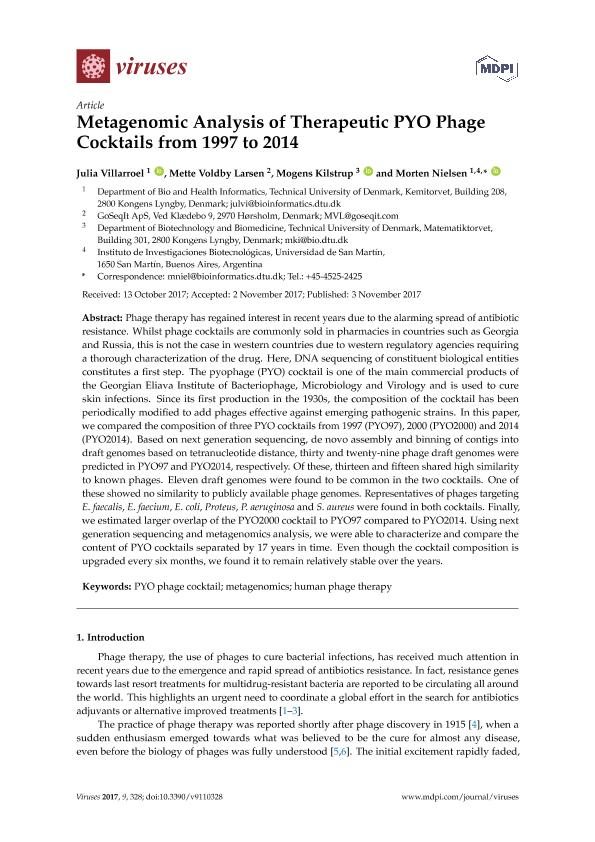Mostrar el registro sencillo del ítem
dc.contributor.author
Villarroel, Julia
dc.contributor.author
Larsen, Mette Voldby
dc.contributor.author
Kilstrup, Mogens
dc.contributor.author
Nielsen, Morten

dc.date.available
2018-06-14T14:49:31Z
dc.date.issued
2017-11
dc.identifier.citation
Villarroel, Julia; Larsen, Mette Voldby; Kilstrup, Mogens; Nielsen, Morten; Metagenomic analysis of therapeutic PYO phage cocktails from 1997 to 2014; MDPI AG; Viruses; 9; 11; 11-2017
dc.identifier.issn
1999-4915
dc.identifier.uri
http://hdl.handle.net/11336/48631
dc.description.abstract
Phage therapy has regained interest in recent years due to the alarming spread of antibiotic resistance. Whilst phage cocktails are commonly sold in pharmacies in countries such as Georgia and Russia, this is not the case in western countries due to western regulatory agencies requiring a thorough characterization of the drug. Here, DNA sequencing of constituent biological entities constitutes a first step. The pyophage (PYO) cocktail is one of the main commercial products of the Georgian Eliava Institute of Bacteriophage, Microbiology and Virology and is used to cure skin infections. Since its first production in the 1930s, the composition of the cocktail has been periodically modified to add phages effective against emerging pathogenic strains. In this paper, we compared the composition of three PYO cocktails from 1997 (PYO97), 2000 (PYO2000) and 2014 (PYO2014). Based on next generation sequencing, de novo assembly and binning of contigs into draft genomes based on tetranucleotide distance, thirty and twenty-nine phage draft genomes were predicted in PYO97 and PYO2014, respectively. Of these, thirteen and fifteen shared high similarity to known phages. Eleven draft genomes were found to be common in the two cocktails. One of these showed no similarity to publicly available phage genomes. Representatives of phages targeting E. faecalis, E. faecium, E. coli, Proteus, P. aeruginosa and S. aureus were found in both cocktails. Finally, we estimated larger overlap of the PYO2000 cocktail to PYO97 compared to PYO2014. Using next generation sequencing and metagenomics analysis, we were able to characterize and compare the content of PYO cocktails separated by 17 years in time. Even though the cocktail composition is upgraded every six months, we found it to remain relatively stable over the years.
dc.format
application/pdf
dc.language.iso
eng
dc.publisher
MDPI AG
dc.rights
info:eu-repo/semantics/openAccess
dc.rights.uri
https://creativecommons.org/licenses/by-nc-sa/2.5/ar/
dc.subject
Human Phage Therapy
dc.subject
Metagenomics
dc.subject
Pyo Phage Cocktail
dc.subject.classification
Salud Ocupacional

dc.subject.classification
Ciencias de la Salud

dc.subject.classification
CIENCIAS MÉDICAS Y DE LA SALUD

dc.title
Metagenomic analysis of therapeutic PYO phage cocktails from 1997 to 2014
dc.type
info:eu-repo/semantics/article
dc.type
info:ar-repo/semantics/artículo
dc.type
info:eu-repo/semantics/publishedVersion
dc.date.updated
2018-06-13T14:57:53Z
dc.journal.volume
9
dc.journal.number
11
dc.journal.pais
Suiza

dc.description.fil
Fil: Villarroel, Julia. Technical University of Denmark; Dinamarca
dc.description.fil
Fil: Larsen, Mette Voldby. GoSeqIt ApS; Dinamarca
dc.description.fil
Fil: Kilstrup, Mogens. Technical University of Denmark; Dinamarca
dc.description.fil
Fil: Nielsen, Morten. Technical University of Denmark; Dinamarca. Consejo Nacional de Investigaciones Científicas y Técnicas. Centro Científico Tecnológico Conicet - La Plata. Instituto de Investigaciones Biotecnológicas. Universidad Nacional de San Martín. Instituto de Investigaciones Biotecnológicas; Argentina
dc.journal.title
Viruses
dc.relation.alternativeid
info:eu-repo/semantics/altIdentifier/doi/https://dx.doi.org/10.3390/v9110328
dc.relation.alternativeid
info:eu-repo/semantics/altIdentifier/url/http://www.mdpi.com/1999-4915/9/11/328
Archivos asociados
